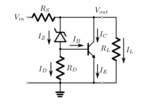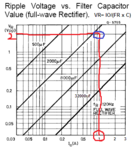Eshal
Advanced Member level 1
- Joined
- Aug 29, 2012
- Messages
- 470
- Helped
- 16
- Reputation
- 32
- Reaction score
- 15
- Trophy points
- 1,298
- Location
- Nowhere :)
- Activity points
- 5,149
@godfreyl
Darlington pass transistor regulator
Basic Series Feedback Regulator
Linear Shunt Regulator with active devices
These are simple design and I want to design anyone of them sir. But I think may be shunt regulator the 3rd one is good among these three. You know better than me, by the way.
@godfreyl and andre_teprom
Dear experts! Here is the graph edited picture. I marked what I think by mind not just a chance.

I have written 2, does 2 should be there where I have written it? I circled a point with blue in color. Does my capacitor value lay there sir?
Actually, we have never been taught how to read graphs in datasheets or not even datasheets in universities so I am blank from these type of talking. But I will appreciate if you experts make me to understand these things too during this tutorial.
thank you all of you.
PS: sorry for late reply due to my internet connection was disabled.
Regards,
Princess
Hello sir, here are these designs:Yes, of course.
Darlington pass transistor regulator

Basic Series Feedback Regulator

Linear Shunt Regulator with active devices

These are simple design and I want to design anyone of them sir. But I think may be shunt regulator the 3rd one is good among these three. You know better than me, by the way.
@godfreyl and andre_teprom
Dear experts! Here is the graph edited picture. I marked what I think by mind not just a chance.

I have written 2, does 2 should be there where I have written it? I circled a point with blue in color. Does my capacitor value lay there sir?
Actually, we have never been taught how to read graphs in datasheets or not even datasheets in universities so I am blank from these type of talking. But I will appreciate if you experts make me to understand these things too during this tutorial.
thank you all of you.
PS: sorry for late reply due to my internet connection was disabled.
Regards,
Princess

